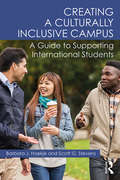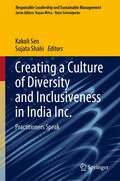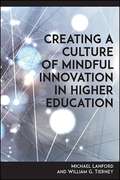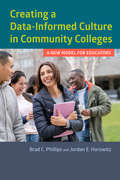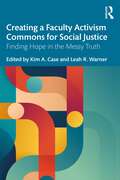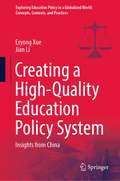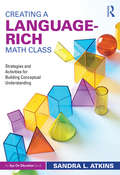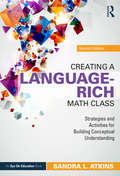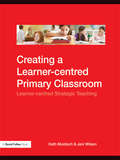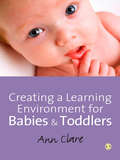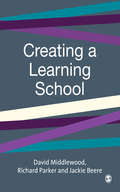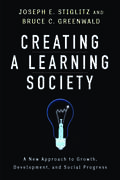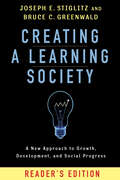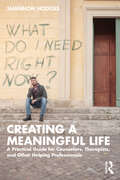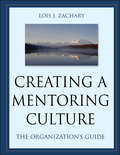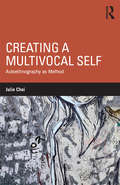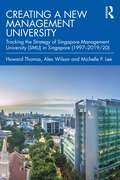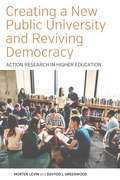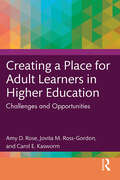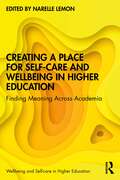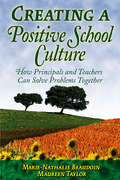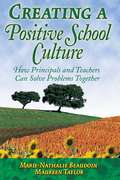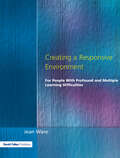- Table View
- List View
Creating a Culturally Inclusive Campus: A Guide to Supporting International Students
by Barbara J. Hoekje Scott G. StevensColleges and universities increasingly recruit international students yet may lack the systems to foster these students' academic success and identity as valued members of the campus community. Sharing case studies of students and examples of innovative initiatives, this book explores strategies and key recommendations for universities to re-conceptualize their programs to better welcome and support international students. Emphasizing the relational aspect of academic and campus life, the authors provide a framework that supports students from initial contact through graduation. Carefully researched and addressing issues of language, engagement, and culture, Creating a Culturally Inclusive Campus offers universities innovative strategies for helping all students fulfull their academic goals while also contributing meaningfully to their school’s global mission.
Creating a Culture of Diversity and Inclusiveness in India Inc.: Practitioners Speak (Responsible Leadership and Sustainable Management)
by Kakoli Sen Sujata ShahiThe book addresses the concept of diversity and inclusiveness (D&I) and brings stories from the corporate, practitioners, think tanks and NGOs. It advocates the need and implementation of the D&I concept to build society of the future. It strives to bring out a focused approach in connecting “Theory to Practice”. Every chapter delves into a different area and presents real-time practices as well as the challenges and the way forward. The book explains the various levels at which discrimination can occur such as demographic profiles, regional differences, religious alliances, college pedigree, marital status, sexual preferences, physical disability and health differentiation, pregnancy or returning mothers and technology competence. The book cites examples of inclusion from progressive organizations such as ABB India, Marico, TCS, PNB Metlife and Alsthom. Presenting the business case of D&I, the book emphasizes on creating a robust D&I strategy with a road map and alignment through internal and external frameworks as well as periodic audits. The Responsible, Accountable, Consultant and Informed (RACI) matrix is discussed while setting up the D&I analytics framework within the organization. The book also presents the growing role of artificial intelligence tools that can empower employees to participate in the D&I journey of an organization. It shares how tools such as Balloonr, Glint, Organization View, Planbox, Pluto and Waggl have been specially designed to allow employees to anonymously provide ideas and respond to ideas provided by others. Going forward, the D&I practices will have to be more customized than generalized, and this book brings up real evidences to make its point
Creating a Culture of Mindful Innovation in Higher Education
by William G. Tierney Michael LanfordHigher education institutions have traditionally nurtured artistic and scientific development and served as catalysts for innovative ideas and products. However, contemporary discourse too often relegates the concept of innovation to the private sector, where the rhetoric of "disruption" frequently reduces innovation to economic terms. As a result, innovations that could benefit society instead exacerbate existing inequities, and the environmental factors that stimulate long-term innovative progress are neglected. Creating a Culture of Mindful Innovation in Higher Education offers a different vision by identifying the conditions that enable college and university administrators, faculty, and staff to promote an innovative institutional culture. Mindful innovation is defined through six central tenets: societal impact; the necessity of failure; creativity through diversity; respect for autonomy and expertise; thoughtful consideration for the dimensions of time, efficiency, and trust; and the incentivization of intrinsic motivation and progress over scare tactics and disruption. Michael Lanford and William G. Tierney offer a clearheaded analysis of the challenges and opportunities in creating a culture of mindful innovation and argue that the institutions that do so will be poised to lead entrepreneurial endeavors, scientific progress, and greater social equity in the twenty-first century.
Creating a Data-Informed Culture in Community Colleges: A New Model for Educators
by Brad C. Phillips Jordan E. HorowitzBrad C. Phillips and Jordan E. Horowitz offer a research-based model and actionable approach for using data strategically at community colleges to increase completion rates as well as other metrics linked to student success. They draw from the fields of psychology, neuroscience, and behavioral economics to show how leaders and administrators can build good habits for engaging with data constructively. At the core of their approach is a strategic effort to help administrators and faculty identify leading indicators that they can affect and monitor before student failure occurs. The book also helps educators make better use of common sources of data, clarify problems to be solved, match research-based interventions to problems, and evaluate results. The authors incorporate strategies for college personnel to engage with data more effectively by integrating student stories into presentations and embedding these discussions into existing meetings and routines. Three case studies from Long Beach City College, Southwestern College, and Odessa College further illustrate how this approach was implemented as part of comprehensive reform efforts. Based on two decades of experience working with colleges across the country, Creating a Data-Informed Culture in Community Colleges promises to be a valuable contribution to the ongoing conversation about information use in education to improve student outcomes.
Creating a Faculty Activism Commons for Social Justice: Finding Hope in the Messy Truth
by David L. Andrews Steven J. JacksonThis timely book shines a light on social justice activism within higher education, calling for a conceptual space of faculty activism to share and build on the work of others who came before.Written by expert social justice academics, this volume provides a collection of honest, critically reflective personal narratives by those who are leading systemic change within their institutions. The faculty authors share openly about their experiences, motivations, challenges, alliances, hopelessness, hopefulness, and what they wish they had known from the start. Topics include addressing systemic racism, changing discriminatory academic policies, establishing resources for historically marginalized students, advocating for a more diverse faculty and staff, educating the campus about bias, among others. This book empowers social justice academics to navigate the complexities of institutional procedures, recognize invisible walls that slow progress, and curate coalitions for systemic change.Uniquely addressing the joys and challenges of creating systemic change, the book will be essential reading for faculty involved in social justice activism within their universities and colleges. The book will also be relevant for all those in the fields of social justice, community engagement, critical higher education, psychology, and sociology.
Creating a High-Quality Education Policy System: Insights from China (Exploring Education Policy in a Globalized World: Concepts, Contexts, and Practices)
by Jian Li Eryong XueThis book explores how to shape a high-quality education system in contemporary China’s education policy system. The high-quality education system includes several dimensions, such as teacher ethics, school–family cooperative system, teacher promotion, the balanced compulsory education system, the integrated rural and urban education, pre-schoolings, special education system, diversified high school system, vocational education, world-class universities, minority group education, private education, off-campus training, and online education system.
Creating a Language-Rich Math Class: Strategies and Activities for Building Conceptual Understanding
by Sandra L. AtkinsWhat meanings do your students have for key mathematics concepts? What meanings do you wish them to have? Creating a Language-Rich Math Class offers practical approaches for developing conceptual understandings by connecting concrete, pictorial, verbal, and symbolic representations. The focus is on making mathematics memorable instead of on memorizing. You’ll learn strategies for introducing students to math language that gives meaning to the terms and symbols they use everyday; for building flexibility and precision in students’ use of math language; and for structuring activities to make them more language-rich. Book Features: Detailed directions for sample games and activities for immediate classroom use; Investigations to Try and Questions for Reflection to assist in implementing these ideas into your practice; Graphic organizer for helping students first understand, solve, and defend their solutions to word problems; Blackline masters of game cards and puzzles (also available at http://www.routledge.com/books/details/9781138916296/)
Creating a Language-Rich Math Class: Strategies and Activities for Building Conceptual Understanding
by Sandra L. AtkinsWhat meanings do your students have for key mathematics concepts? What meanings do you wish them to have? Creating a Language-Rich Math Class offers practical approaches for developing conceptual understandings by connecting concrete, pictorial, verbal, and symbolic representations. The focus is on making mathematics memorable instead of on memorizing. You’ll learn strategies for introducing students to math language that gives meaning to the terms and symbols they use every day; for building flexibility and precision in students’ use of math language; and for structuring activities to make them more language-rich. This second edition also provides strategies for helping students to at times be quiet and listen to their peers; for purposefully using language to introduce students to more complex mathematical symbolism and algebraic properties; and for using writing prompts to zoom in on the meanings that individual students have given to the language-rich experiences. Appropriate for elementary teachers and instructional coaches, the book also includes features such as Investigations to Try and Questions for Reflection to help you incorporate these ideas into your practice. In addition, there are Blackline masters of game cards and puzzles, which can also be found on our website for free download at http://www.routledge.com/9780367759957.
Creating a Learner-centred Primary Classroom: Learner-centered Strategic Teaching
by Kath Murdoch Jeni WilsonCreating a Learner-centred Primary Classroom is an essential resource to improve teaching practice, examining the key elements that contribute to a learner-centred classroom and offering strategies to encourage children to take a shared role in their learning. Including case studies describing teachers’ methods for linking theory to practice, this user-friendly, photocopiable resource demonstrates how to: construct a learning community encourage collaborative learning share strategies for engaging individual learners provide a scaffold for strategic thinking in the classroom link assessment procedures to learning showcase the practice and outcomes of purposeful curriculum planning. Any teacher who wants to practically tailor their teaching practice to meet the needs of individual learners will find this an invaluable resource.
Creating a Learning Environment for Babies and Toddlers
by Mrs Ann ClareShortlisted for the 2012 Nursery World Awards! Understanding the factors that contribute to a positive learning environment is vital for those working with children from birth to 3 years. Using extensive case study material, Ann Clare focuses on the experiences of babies and toddlers in various care settings, and the role adults play in developing creative and supportive environments. The effect on speech and language development is explored, with reference to recent research and initiatives. Information gathered from parents and childcare workers helps provide a deep consideration of parents' childcare choices. Topics covered include: - the emotional environment - the role of adults in the environment - the physical environment - the creative environment - parents and the environment - observing and questioning This detailed study of current research and literature provides an invaluable source of information for those planning to work with babies and toddlers, as well as experienced childminders wanting to reflect on the care and learning they offer children and families. Ann Clare is an Early Years Foundation Stage Consultant in England.
Creating a Learning School
by Richard Parker David Middlewood Ms Jackie Beere'Improving the quality of learning and teaching is the most important thing that school leaders do. This book contains much that will help the reader in that enterprise. It reflects the fact that much of what we know about effective, high-quality schools is already 'out there' in schools across the country. The book mines that gold. It is full of good sense, a treasure chest of helpful ideas which have the credibility of being grounded in case-study material, and in the experience of the authors, two of whom are practising headteachers. The book sets out the principles underpinning the Learning School, but offers also a strong pragmatic focus and is organized so that it can be dipped into and something worthwhile easily found. It sets out practical and specific steps to creating the Learning School and will support change and improvement in the professional practices involved in making a school a stimulating learning environment for adults as well as students' - Dr Martin J Coles, Assistant Director, National College for School Leadership '[C]learly set out, passionately and well-written, covering much material, full of interesting insights, as one might expect from two head teachers and an acknowledged expert in the field... Lots of interesting thoughts and ideas, written in an accessible style. I would certainly recommend this book to my students' - ESCalate The schools of the 21st century cannot continue to apply the techniques of the 20th century. 'New Learning' dispenses with outdated preoccupations with tests, targets, and leadership from above, and focuses on independence of learning and structural flexibility within schools. The authors give a complete overview of how schools can adapt to meet changing needs. They look at the teacher as learner, learning outside the classroom, and the nature of leadership in learning schools, and provide practical solutions to the problems of staffing, resourcing and assessment. This book is an invaluable resource for all mid-to-upper level managers in schools, anyone aspiring to these positions, or anyone who takes a longterm view of the future of educational practice.
Creating a Learning Society
by Philippe Aghion Joseph E. Stiglitz Kenneth J. Arrow Robert M. Solow Bruce C. GreenwaldIt has long been recognized that most standard of living increases are associated with advances in technology, not the accumulation of capital. Yet it has also become clear that what truly separates developed from less developed countries is not just a gap in resources or output but a gap in knowledge. In fact, the pace at which developing countries grow is largely determined by the pace at which they close that gap.Therefore, how countries learn and become more productive is key to understanding how they grow and develop, especially over the long term. In Creating a Learning Society, Joseph E. Stiglitz and Bruce C. Greenwald spell out the implications of this insight for both economic theory and policy. Taking as a starting point Kenneth J. Arrow's 1962 paper "Learning by Doing," they explain why the production of knowledge differs from that of other goods and why market economies alone are typically not efficient in the production and transmission of knowledge. Closing knowledge gaps, or helping laggards learn, is central to growth and development.Combining technical economic analysis with accessible prose, Stiglitz and Greenwald provide new models of "endogenous growth," upending the received thinking about global policy and trade regimes. They show how well-designed government trade and industrial policies can help create a learning society; explain how poorly designed intellectual property regimes can retard learning; demonstrate how virtually every government policy has effects, both positive and negative, on learning; and they argue that policymakers need to be cognizant of these effects. They provocatively show why many standard policy prescriptions, especially associated with "neoliberal" doctrines focusing on static resource allocations, impede learning and explain why free trade may lead to stagnation, while broad based industrial protection and exchange rate interventions may bring benefits, not just to the industrial sector, but to the entire economy.The volume concludes with brief commentaries from Philippe Aghion and Michael Woodford, as well as from Nobel Laureates Kenneth Arrow and Robert Solow.
Creating a Learning Society: A New Approach to Growth, Development, and Social Progress (Kenneth J. Arrow Lecture Series)
by Joseph E. Stiglitz Bruce C. Greenwald&“A superb new understanding of the dynamic economy as a learning society, one that goes well beyond the usual treatment of education, training, and R&D.&”—Robert Kuttner, author of The Stakes: 2020 and the Survival of American Democracy Since its publication Creating a Learning Society has served as an effective tool for those who advocate government policies to advance science and technology. It shows persuasively how enormous increases in our standard of living have been the result of learning how to learn, and it explains how advanced and developing countries alike can model a new learning economy on this example. Creating a Learning Society: Reader&’s Edition uses accessible language to focus on the work&’s central message and policy prescriptions. As the book makes clear, creating a learning society requires good governmental policy in trade, industry, intellectual property, and other important areas. The text&’s central thesis—that every policy affects learning—is critical for governments unaware of the innovative ways they can propel their economies forward. &“Profound and dazzling. In their new book, Joseph E. Stiglitz and Bruce C. Greenwald study the human wish to learn and our ability to learn and so uncover the processes that relate the institutions we devise and the accompanying processes that drive the production, dissemination, and use of knowledge . . . This is social science at its best.&”—Partha Dasgupta, University of Cambridge &“An impressive tour de force, from the theory of the firm all the way to long-term development, guided by the focus on knowledge and learning . . . This is an ambitious book with far-reaching policy implications.&”—Giovanni Dosi, director, Institute of Economics, Scuola Superiore Sant&’Anna &“[A] sweeping work of macroeconomic theory.&”—Harvard Business Review
Creating a Learning Society: A New Approach to Growth, Development, and Social Progress (Kenneth J. Arrow Lecture Series)
by Joseph E. Stiglitz Bruce GreenwaldIt has long been recognized that an improved standard of living results from advances in technology, not from the accumulation of capital. It has also become clear that what truly separates developed from less-developed countries is not just a gap in resources or output but a gap in knowledge. In fact, the pace at which developing countries grow is largely a function of the pace at which they close that gap. Thus, to understand how countries grow and develop, it is essential to know how they learn and become more productive and what government can do to promote learning. In Creating a Learning Society, Joseph E. Stiglitz and Bruce C. Greenwald cast light on the significance of this insight for economic theory and policy. Taking as a starting point Kenneth J. Arrow's 1962 paper "Learning by Doing," they explain why the production of knowledge differs from that of other goods and why market economies alone typically do not produce and transmit knowledge efficiently. Closing knowledge gaps and helping laggards learn are central to growth and development. But creating a learning society is equally crucial if we are to sustain improved living standards in advanced countries. Combining accessible prose with technical economic analysis, Stiglitz and Greenwald provide new models of "endogenous growth," up-ending thowhe thinking about both domestic and global policy and trade regimes. They show well-designed government trade and industrial policies can help create a learning society, and how poorly designed intellectual property regimes can retard learning. They also explain how virtually every government policy has effects, both positive and negative, on learning, a fact that policymakers must recognize. They demonstrate why many standard policy prescriptions, especially those associated with "neoliberal" doctrines focusing on static resource allocations, have impeded learning. Among the provocative implications are that free trade may lead to stagnation whereas broad-based industrial protection and exchange rate interventions may bring benefits—not just to the industrial sector, but to the entire economy. The volume concludes with brief commentaries from Philippe Aghion and Michael Woodford, as well as from Nobel Laureates Kenneth J. Arrow and Robert M. Solow.
Creating a Learning Society: A New Approach to Growth, Development, and Social Progress, Reader's Edition (Kenneth J. Arrow Lecture Series)
by Joseph E. Stiglitz Bruce GreenwaldSince its publication Creating a Learning Society has served as an effective tool for those who advocate government policies to advance science and technology. It shows persuasively how enormous increases in our standard of living have been the result of learning how to learn, and it explains how advanced and developing countries alike can model a new learning economy on this example. Creating a Learning Society: Reader's Edition uses accessible language to focus on the work's central message and policy prescriptions. As the book makes clear, creating a learning society requires good governmental policy in trade, industry, intellectual property, and other important areas. The text's central thesis—that every policy affects learning—is critical for governments unaware of the innovative ways they can propel their economies forward.
Creating a Meaningful Life: A Practical Guide for Counselors, Therapists, and Other Helping Professionals
by Shannon HodgesCreating a Meaningful Life builds on the tenets of mindfulness-based cognitive therapy (MBCT) to answer some of life’s basic questions, such as "How do I create a meaningful, purposeful life?" and "Is the life I am living one that brings me fulfillment, purpose, and a sense of inner peace?" Using a variety of techniques, including journaling, grounding exercises, cognitive self-talk restructuring, and more, chapters invite counseling professionals and students to explore their inner landscape, better understand themselves and find communion with others.
Creating a Mentoring Culture
by Lois J. ZacharyIn order to succeed in today's competitive environment, corporate and nonprofit institutions must create a workplace climate that encourages employees to continue to learn and grow. From the author of the best-selling The Mentor's Guide comes the next-step mentoring resource to ensure personnel at all levels of an organization will teach and learn from each other. Written for anyone who wants to embed mentoring within their organization, Creating a Mentoring Culture is filled with step-by-step guidance, practical advice, engaging stories, and includes a wealth of reproducible forms and tools.
Creating a Multivocal Self: Autoethnography as Method
by Julie ChoiShowcasing a new methodology in language learning and identity research, this carefully conceptualized, innovative book explicates the use of autoethnography as a way of re-imagining one’s sense of linguistic and cultural identity. A key work for researchers and students in Applied Linguistics and Language Education, it addresses fundamental aspects of research methodology and explores substantive issues relating to individual dimensions of multilingualism. Choi shows convincingly how the learning of a language is inseparable from one’s constant searching for a voice, a place, and a self in this world, demonstrating the importance of interrogating what lies behind everyday life events and interactions—the political and ethical implications of the utterances, thoughts, actions, and stories of the self and others. Themes of authenticity, illegitimacy, power relations, perceptions of self/other, cultural discourses and practices, and related issues in multilingual identity development surface in the multi-modal narratives. Chapters on methodology, woven through the book, focus on the process of knowledge production, approaches to writing narratives, the messiness of research writing practices, and the inseparability of writing and research.
Creating a New Management University: Tracking the Strategy of Singapore Management University (SMU) in Singapore (1997–2019/20)
by Howard Thomas Alex Wilson Michelle P. LeeThis book provides an in-depth exploration of one of the most significant success stories of the development of an entrepreneurial university in recent times as well as its role within society and the economy. Written by leading business school Dean and scholar, Howard Thomas, and Alex Wilson and Michelle Lee, the book tracks the genesis of the idea of a third local university in Singapore to its fruition as Singapore Management University (SMU). It provides important insight and lessons for senior university and business school leaders, as well as regional and national governments. The increasing emphasis on the importance of innovative, entrepreneurial universities for social and economic growth has prompted this review of the strategy and impact of SMU. The book addresses the strategic evolution of SMU itself, from its origins as a single business school, into a multi-school, social science-focused school of management. It examines whether it has fulfilled its promise as an entrepreneurial university and a change agent in the context of Singapore’s strong economic growth and educational strategy. More broadly, it explores how investment in education, and entrepreneurial universities such as SMU, can facilitate and enhance economic growth. University leadership teams, policy analysts, faculty and students of entrepreneurship education, education management and policy in general, and business education in particular, will find this book an invaluable insight into building a genuinely entrepreneurial university.
Creating a New Public University and Reviving Democracy: Action Research in Higher Education (Higher Education in Critical Perspective: Practices and Policies #2)
by Morten Levin Davydd J. GreenwoodPublic universities are in crisis, waning in their role as central institutions within democratic societies. Denunciations are abundant, but analyses of the causes and proposals to re-create public universities are not. Based on extensive experience with Action Research-based organizational change in universities and private sector organizations, Levin and Greenwood analyze the wreckage created by neoliberal academic administrators and policymakers. The authors argue that public universities must be democratically organized to perform their educational and societal functions. The book closes by laying out Action Research processes that can transform public universities back into institutions that promote academic freedom, integrity, and democracy.
Creating a Place for Adult Learners in Higher Education: Challenges and Opportunities
by Amy D. Rose Carol E. Kasworm Jovita M. Ross-GordonCreating a Place for Adult Learners in Higher Education offers deep insights into how to attract, teach, support, and retain students over the age of 25 – an important yet often overlooked student group. Comprehensive in scope, this book covers all the main aspects of adult students’ relationships with higher education institutions: recruitment, admissions, and financing; course and program provision and teaching approaches; and student support, retention, and completion. The discussion is bolstered by chapters of analysis on adult student demographics (including both diversities and commonalities), exploration of leadership challenges, and discussion of measurements of success. Drawing from the most up-to-date research as well as practical experience and descriptions of best practices by programs historically serving adults, the authors provide a broad set of strategies and recommendations to place adult students at the center of the educational process. Higher education leaders, practitioners, and administrators will find this book an invaluable resource as they seek to better account for and support this key student group, which now comprises approximately 30% of the US undergraduate population.
Creating a Place for Self-care and Wellbeing in Higher Education: Finding Meaning Across Academia (Wellbeing and Self-care in Higher Education)
by Narelle LemonThe workplace has significant influence over our sense of wellbeing. It is a place where many of us spend significant amounts of our time, where we find meaning, and often form a sense of identity. Creating a Place for Self-care and Wellbeing in Higher Education explores the notion of finding meaning across academia as a key part of self-care and wellbeing. In this edited collection, the authors navigate how they find meaning in their work in academia by sharing their own approaches to self-care and wellbeing. In the chapters, visual narratives intersect with lived experience and proactive strategies that reveal the stories, dilemmas, and tensions of those working in higher education. This book illuminates how academics and higher education professionals engage in constant reconstruction of their identity and work practices, placing self-care at the centre of the work they do, as well as revealing new ways of working to disrupt the current climate of dismissing self-care and wellbeing. Designed to inspire, support, and provoke the reader as they navigate a career in higher education, this book will be of great interest to professionals and researchers specifically interested in studies in higher education, wellbeing, and/or identity.
Creating a Positive School Culture: How Principals and Teachers Can Solve Problems Together
by Dr Marie-Nathalie Beaudoin Ms Maureen E. TaylorBased on more than 200 interviews, this practical guidebook provides strategies for solving staff problems, preventing conflicts, and enriching school climates.
Creating a Positive School Culture: How Principals and Teachers Can Solve Problems Together
by Marie-Nathalie Beaudoin Maureen TaylorPrincipals and teachers have very different perspectives, pressures, and struggles. As a result, problems of negativity, isolation, or censure often develop among staff members. This may cause principals and teachers to spend a tremendous amount of energy addressing these issues instead of focusing on their primary goal—improved student achievement. Creating a Positive School Culture provides strategies for understanding and solving staff problems, preventing conflicts, and enriching school climates. By combining therapeutic knowledge with day-to-day educational experience, the authors offer innovative solutions for overcoming many energy- and morale-sapping problems, including gossip, cliques, negativity, and competition. To help engage and inspire readers, this volume includes: - Teacher and principal interview excerpts - Concise case examples of school culture problems - Step-by-step guidance for school culture interventions - Best practices culled from the authors’ extensive research - Ready-to-use tools, including school culture surveys and staff development exercises Based on more than 200 surveys and interviews with principals and teachers, this practical guidebook clearly explains how administrators, teachers, parents, and staff can all work together to solve problems and build a culture of caring and respect.
Creating a Responsive Environment for People with Profound and Multiple Learning Difficulties
by Jean WareThis revised and updated second edition aims to enable teachers and care staff working with people with PMLD in any context to create a positive interactive environment for the people with whom they work. Using information from the latest research and from everyday practice, the author discusses the different aspects of a responsive environment and suggests practical strategies that staff can use to create such an atmosphere.
